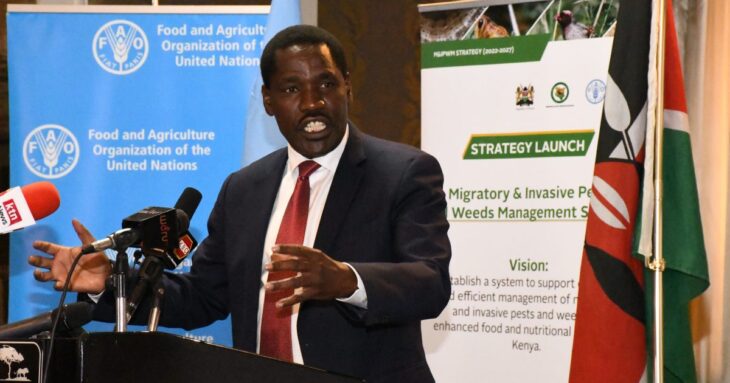NAIROBI, Kenya, Feb 8(KNA)- The government and other partners have intensified efforts to fully eliminate pests, which have been a great threat to food security in the country.
Consequently, the Ministry of Agriculture in partnership with FAO and World Bank has launched the Migratory and Invasive Pests and Weeds Management Strategy 2022-2027 to deal with the pests that have negatively affected international trade.
Speaking during the launch in a Nairobi hotel, Agriculture, livestock, and Cooperatives CS Peter Munya emphasized the government’s effort to reduce the pests’ threat, which has been causing huge losses, thus affecting the livelihoods of millions of people.
Munya noted that climate change has led to the emergence of pests and diseases that have not been experienced over a long period of time, with migratory pests and invasive pests posing a new challenge in the Eastern Africa region.
He cited that the Desert Locust (DL) invasion experienced in Kenya over the last two years, posed a severe food security threat to over 4 million people, affecting a total of 32 counties in North eastern, coastal, central, eastern and Rift Valley regions of Kenya, thus the need to strengthen agricultural systems and build resilience to manage crisis sustainability.
“It is in this respect that the Ministry of Agriculture with the support of Food and Agriculture Foundation (FAO) and World Bank spearheaded the development of the strategy for management of Migratory Invasive pests,” said Munya.
The strategy, he said, has identified seven priority pillars for a comprehensive migratory pest management system and will provide a platform for a coordinated collaborative approach, adding that it will establish a modern information and knowledge management system.
Munya said that this system will strengthen surveillance, forecasting and ensure timely and effective control operations.
“The ministry continues working closely with regional and global organizations and national and county stakeholders and the donor community to support implementation of this strategy,” said the CS.
He appreciated FAO for providing technical support in the development of the strategy and also the World Bank through Emergency Locust Response Project (ELRP) for providing funds for the strategy.
In her remarks, the Deputy Director General FAO Ms. Beth Bechdol said that the launch is a big milestone because Migratory and invasive pests like Quelea birds, African armyworm, desert locust and invasive weeds like the water hyacinth pose severe constraints to food and nutritional security in invaded and infested areas.
“As FAO, we are delighted to have been part of the team that has contributed to the conceptualization and development of this strategy and we trust that implementation of this strategy by the national and county governments, which we commit to continue being part of, will steer management of migratory and invasive pests and weeds and ensure livelihoods recovery, restoration and resilience for affected communities,” said Bechdol.
A Senior Agricultural Economist Vinay Kunar Vutukuru said the World Bank will in two months’ time loan the government Sh22.7 billion to support various development projects designed to enhance food and nutrition security.
“The Migratory and Invasive Pests and Weeds Management Strategy launch is such a big milestone for Kenya and the World Bank is committed to support the Kenyan government,” he said.
The launching of the Migratory and Invasive Pests and Weeds Management Strategy comes in through its seven pillars namely capacity building, early warning, surveillance, control operation and livelihood restoration.
Want to send us a story? Contact Shahidi News Tel: +254115512797 (Mobile & WhatsApp)


